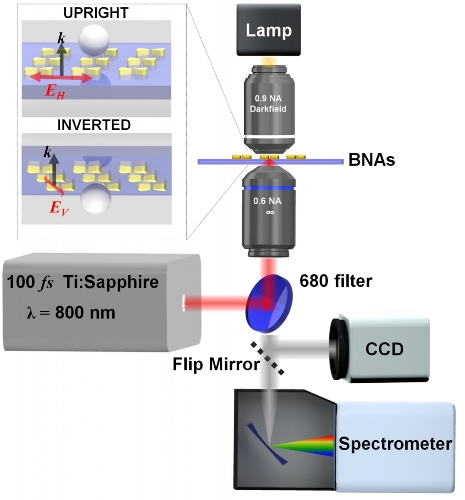Employing ultra-low input power densities, a research group from the University of Illinois at Urbana-Champaign has shown the possibility of using low-power ‘optical nanotweezers’ for trapping, manipulating and analyzing nanoparticles, including delegate biological samples.
 This is the experimental setup schematic showing laser source, microscope, and imaging detector and spectrometer. Inset illustrates the two different sample configurations that were explored; the red arrows correspond to the input polarization directions and the black arrows depict the propagation vector. (credit: University of Illinois)
This is the experimental setup schematic showing laser source, microscope, and imaging detector and spectrometer. Inset illustrates the two different sample configurations that were explored; the red arrows correspond to the input polarization directions and the black arrows depict the propagation vector. (credit: University of Illinois)
Kimani Toussaint, Jr., one of the researchers, explained that the research team demonstrated for the first time the possibility to further improve the near-field optical forces by leveraging the associated high-peak powers with the help of a femtosecond optical source but without making any alterations in the fabrication process. For trapping, manipulating and analyzing the nanoparticles, the team utilized 50 µW average power, which is 100x power lesser than that can be generated from a typical laser pointer.
This system is suitable for biological (lab-on-a-chip) applications like cell manipulation as it runs at average power levels roughly three orders of magnitude lesser than the estimated optical damage threshold for biological structures, said Toussaint. This technology provides improved local diagnostic capabilities by enabling the exploration of trapped specimens’ nonlinear optical response and allowing for analyses of in vitro fluorescent-tagged cells or viruses, utilizing a single line for detaining and analysis instead of multiple laser lines.
In the paper, ‘Femtosecond-pulsed plasmonic nanotweezers’ which appeared in Scientific Reports, the research team discussed how Au bowtie nanoantennas arrays (BNAs)’ trapping strength is improved drastically using a femtosecond-pulsed laser beam and demonstrated optical trapping using plasmonic nanotweezers with the help of a femtosecond source.
First author, Brian Roxworthy stated that the manifestation of controlled particle fusing paves the way to develop innovative nanostructures and improves the local magnetic field response, which is essential for the magnetic plasmonics field. In the paper, the researchers also showed trap stiffness improvement of up to 5x when compared to traditional optical tweezers that use a femtosecond source and 2x when compared to continuous-wave nanotweezers, enabling detaining and tweezing of dielectric, metal, fluorescent and non- fluorescent particles, as well as spherical particles varying between 80 nm and 1.2 µm in diameter; silver nanoparticle fusing to the BNAs; roughly 3.5x more improvement of the second-harmonic signal for the combined nanoparticle-BNA system than the bare BNAs; and improvement of two-photon fluorescent signal received from detained microparticles when compared to the response in the absence of the BNAs.